GALLUP NEWS SERVICE
The Gallup Poll has been asking Americans questions for over 60 years, and while the topics of the polls have covered the entire range of news events and trends that have occurred since 1935, some basic questions have remained constant throughout this entire time period. This review looks back at some of the more enduring measures that provide a fascinating portrait of the way in which American public opinion has changed in some ways -- and stayed the same in many others.
The Gallup Poll does not extend back through the entire century that comes to a close on December 31, but does span about two-thirds of it. Gallup asked its first official question in September 1935 and has been asking Americans for their opinions about almost every conceivable issue, phase of life and news event since that time.
Some of the topics for Gallup Poll questions have come and gone. In the 1940s, Gallup interviewers were asking about wartime rations, in the 1950s the Korean War , in the 1960s civil rights riots, in the 1970s Watergate, in the 1980s and even in the 1990s such topics as the Clarence Thomas confirmation hearings and the O.J. Simpson trial, which occupied a great deal of Gallup Poll attention, have now faded in terms of their contemporary interest.
But other Gallup Poll topics have been more enduring parts of the American landscape and have survived intact over the years. The concerns and opinions of Americans on these issues are just as relevant and interesting today as they were when Gallup first began asking about them decades ago, and for that reason they have been continually updated throughout the years.
This special end-of-the-century review looks at a dozen of these enduring measures. None of these are intended to provide a complete understanding of public opinion in the specific area. For that, The Gallup Poll's long and rich archives should be consulted. Our hope is that the highlights presented here will spur our readers to explore them.
1. Presidential Job Approval
Do you approve or disapprove of the way (the president) is handling his job as president?
This question, described as "the most frequently asked question in the history of survey research," was first developed by Dr. Gallup during the Roosevelt presidency, starting in 1935, as a way to evaluate public support for the president between elections. As discussed in the definitive "Presidential Approval: A Sourcebook" by George C. Edwards and Alec M. Gallup:
Gallup's early efforts to develop some kind of presidential "popularity" rating to reveal how Americans felt about Franklin Delano Roosevelt were confined to questions concerning whether they would vote for him again rather than whether they liked him or the job he was doing. … By August of 1937, however, Gallup had abandoned voting intention questions in favor of questions more akin to the current approach.
Some of the earlier wordings included references to the president's job performance "in general," or "today." However, according to Edwards and Gallup, the current wording, used continuously by The Gallup Poll since its formulation and subsequently adopted by most other major polling organizations around the country, was settled on during the Truman administration in 1945.
The chart below summarizes presidential job approval ratings on the basis of annual averages for each president since Harry Truman. The ever-changing figures parallel major events in American social, economic and political life this century, as well as presidential triumphs and scandal, and make clear the public scrutiny faced by those who occupy the Oval Office. As varied as the line-graph pattern is, it masks the most dramatic individual job approval figures in Gallup's archives, including the lowest rating on record of 22% given to Harry Truman in February 1952, and the highest rating of 89% given to George Bush during the Gulf War in February 1991. Close to 1,000 individual ratings make up the summary presented here, and represent the largest and longest public opinion time-series anywhere in the world.
|
|
2. Willingness to Support a Woman for President
Gallup first asked the public about its willingness to vote for a woman for president in 1937, at the earliest stage of The Gallup Poll. At that point, only a third of the public said they would vote for a woman. (It may be well to remember how different the times were when Gallup first asked this question in 1937: it had been only 17 years since women were given the right to vote with the ratification of the 19th Amendment.) Changes began to occur rapidly in these attitudes soon after the end of World War II, however. By 1949, the "yes" response had risen to 48%, and by 1955, a majority -- 52% -- said it would vote for a woman.
This bare majority percentage, however, stayed remarkably constant for the next 14 years, with only 53% saying they would vote for a woman as late as 1969. Many American attitudes shifted significantly during the time period of the late 1960s and the early 1970s, as the country was roiled by Vietnam, the maturing into adulthood of the baby boom generation, the hippie and other countercultural movements and Watergate. Women's consciousness also began to shift and by 1971, a significant change in this "woman for president" indicator took place. By 1971, two-thirds of the public said yes to the question. The percentage continued to climb, reaching 78% in 1984, the year in which a woman, Geraldine Ferraro, became the Democratic nominee for vice president.
In 1999, another woman, Elizabeth Dole, made a serious run at the Republican presidential nomination, as 92% of Americans said they would vote for a woman candidate. Still, it is worth noting that even today, 7% of Americans -- more men than women -- say they would not be willing to vote for a woman for president.
 |
3. Willingness to Support a Black for President
Gallup's first asking of this question came in 1958, at which time only 38% of the public said "yes" -- that they would be willing to vote for a black for president. As was true for the "woman for president" question, the major shifts in the responses came in the 1960s and into the 1970s, coincident not only with the turmoil of Vietnam and the countercultural flowering of the hippie age, but also with an enormous amount of activity, protest and legislation on the civil rights front. In fact, between 1963 and 1965, as the Civil Rights Act of 1964 was passed, the percentage of Americans saying they would be willing to vote for a black for president moved up 9 percentage points to a majority of 59% for the first time. By 1969, two-thirds of Americans said they would vote for a black, and the number has been climbing since then.
In the ten-year span between 1987 and 1997, the yes percentage jumped from 79% to 93%, and earlier this year it reached 95% -- essentially universal willingness to state to an interviewer that the race of a candidate for president would make no difference. There has yet to be an African American candidate for president who has advanced to be a serious contender for the nation's highest office -- although Jesse Jackson has been a serious contender for the Democratic nomination in some years. Also, as of December 1999, the black candidate Alan Keyes was still officially in the running for the Republican presidential nomination, and polls have shown over the past decade that retired General Colin Powell would be a very formidable presidential candidate for either party if he were to decide to run.
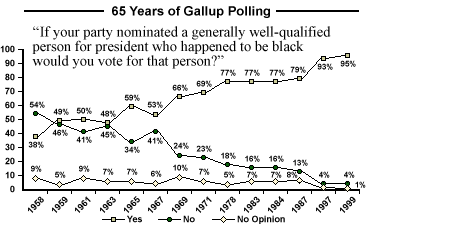 |
4. Biggest Threat to the Country: Big Business, Big Labor or Big Government
In the mid-1960s, one economic framework used to help explain economic forces in the country was that of countervailing power. This was the notion that big businesses and labor unions would struggle against each other, each group trying to protects its own interests, while the federal government would act as a balance of power, to ensure that neither of the other two participants became too strong and thus a threat to the country's economy. It was perhaps this framework that gave rise to a Gallup question that has been asked four times in the 1960s, three times each in the 1970s and 1980s, and twice in the 1990s: "Which of the following will be the biggest threat to the country in the future: big business, big labor, or big government?"
The question may very well have taken on a different meaning over the years, as the theory of countervailing power has given way to more sophisticated economic frameworks that no longer ignore international commerce, and as labor unions have become less of an economic force in this country. The trends in the answers to the question show a substantial increase in the number of Americans who now say "big government" rather than "big labor" or "big business." And with the decline in labor union membership, "big labor" is seen as the biggest threat by less than one in ten Americans, a drop of more than twenty points from when the question was first asked three and a half decades ago.
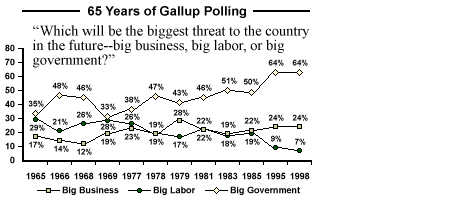 |
5. Cigarette Smoking and Lung Cancer
The Gallup Poll first measured public attitudes about the connection between cigarette smoking and lung cancer in January 1954, asking Americans "What is your opinion -- do you think cigarette smoking is one of the causes of lung cancer, or not?"
At that time -- after medical studies that linked smoking with cancer had been publicized in the news, but before the United States surgeon general's warnings of the mid-1960s were issued -- only 41% of Americans answered in the affirmative. Close to one-third, 31%, said smoking did not cause cancer while the remaining 29% were unsure. Other Gallup polling of the time showed widespread awareness of reports that cigarette smoking "may be a cause of cancer of the lung," with 90% saying they had recently heard or read about this possibility. Seven in ten also viewed smoking as harmful, generally. A follow-up question asking Americans in what ways they believe smoking is harmful sheds interesting light on the seriousness of the public's health concerns about smoking in that era, and can be compared with a recent update on the measure.
The trend line below shows the gradual but steady increase in public acceptance of the link between smoking and cancer that occurred over the next 40 years, according to Gallup's direct question on the issue. The most dramatic short-term change in public attitudes on the cancer question occurred between 1960 and 1969, spanning the time during which the surgeon general issued his first public report on smoking (in 1964) and during which Congress required the first cigarette package warning labels. At the beginning of the decade only 50% believed smoking was a cause of cancer; by 1969, that figure had grown to 70%. Since then, agreement that smoking causes lung cancer has increased by an average of one percentage point per year; such agreement is now shared by more than nine in ten Americans.
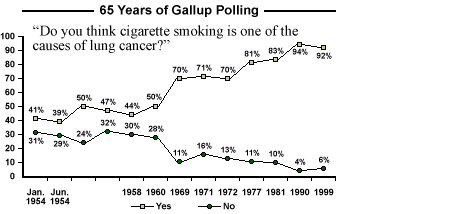 |
6. Ideal Number of Children
According to United Nations statistics, the annual rate of world population growth peaked at about 2% in the early 1960s and has gradually slowed ever since. The latest U.N. population figures indicate that the world's population is now growing by just over 1.3%, or about 78 million people per year. The United Nations cites desired family size as one of the key factors in world population trends, and partially credits a decrease in the number of children desired by women for the slowing in population growth.
With a question that asks "What do you think is the ideal number of children for a family to have," Gallup has recorded dramatic changes in attitudes about family size in the United States over the last half century. When first measured by Gallup in 1936, two-thirds of Americans thought that three or more children were ideal. The average (mathematical mean) number of children preferred was 3.6. Those preferences held steady for the next three decades, through a poll conducted in 1967. Then, the next Gallup poll to ask the "ideal number of children" question, conducted in 1973, recorded a substantial change -- with preference for three or more children declining to 43% and the mean number preferred dropping to 2.8. By 1980, the figures had fallen further, to 32% favoring three or more children, and just 2.5 for the mean. U.S. opinion on this issue has been mostly stable at this level since 1980, although a significant upward trend was seen when the issue was last measured in 1997.
It is interesting to note that trends in U.S. preferences for family size are generally consistent with birth statistics over the same time period. From the end of World War II through 1967, the average number of children born to women in the United States was relatively high, ranging from 2.7 to 3.7. That fell to 1.9 by 1973 and was estimated at 2.1 for 1997.
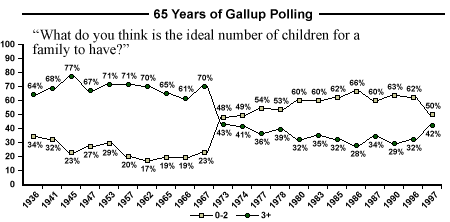 |
7. Church Attendance
This is an enduring behavioral recall measure of religion that has undergone remarkably little change over the last 30 years. The high point for this measure of church attendance came in the mid-1950s to mid-1960s, when -- coincident with the huge number of baby-boom children coming of age across the country -- almost half of Americans said that they had gone to church "in the last seven days." This percentage fell back to roughly the 40% range by the early 1980s, however, and has stayed at almost precisely that point ever since.
In the broadest sense, the percentage of churchgoers today -- based on this measure -- is almost exactly what it was in 1939 when Gallup first asked the question to a nationwide sample. Despite the enormous changes that have roiled society through the 1970s, 1980s and 1990s, almost exactly the same numbers of Americans in survey after survey, year after year, during this period of time, have said that they attended church at some point during the previous seven days.
Interestingly, this measure has been one of the most widely analyzed of all Gallup Poll questions, and scholars throughout the years have looked into exactly what it is measuring. One team of sociologists, in fact, selected a specific county in Ohio, and spent months attempting to count cars in church parking lots and obtain other measures of "real" church attendance to see if they could match the number of warm bodies in pews with what the responses to the question in surveys administered in the same county would suggest (they couldn't). While the measure most probably is not a precise indicator of the exact number of people who attend church on specific weeks, the fact that it has remained so constant over the years is an important indicator of the stability of a broad attitudinal indicator of religiosity in the American population.
 |
8. The Federal Income Tax
A government tax on income is a relatively recent form of taxation, although it was imposed sporadically in medieval Italian cities. The first major income tax in modern societies was a temporary one imposed in England at the end of the 18th century, for war revenue. The United States imposed its first income tax in 1864, to help fight the Civil War, but discontinued that tax eight years later. In 1894, a federal income tax was enacted into law, but was declared unconstitutional. This prompted Congress to pass the Sixteenth Amendment, eventually ratified by the states and taking effect in 1913, allowing the income tax to become a permanent part of the federal tax structure.
Shortly after World War II, Gallup asked Americans whether they considered "the amount of federal income tax you have to pay as too high, about right, or too low." In almost all of the years since then, a majority of Americans have opted to say "too high," with never more than a couple of percent saying "too low."
The two major exceptions to this pattern occurred during especially troubled times involving Berlin, the focal point of Cold War tensions between the United States and the Western world on one hand, and the Soviet Union and its satellites on the other. When the tax question was asked in March, 1949, the United States was in the midst of a massive airlift of supplies from Western countries to Berlin, because of the "blockade" imposed by East Germany forbidding any land travel from West Germany to the interior of East Germany, where Berlin was located. The fear that this action could lead to a new world war was widespread, and it is possible that this situation was the reason why a majority of Americans, for the only time in the half century when they were asked this question, said that the amount of federal taxes they were paying was "about right."
The only other time when a majority of Americans did not say federal taxes were too high was in the 1961-1962 period, again a period of great uncertainty about Berlin and the possibility of a new world war. During this period of the "Berlin Crisis," the Soviet Union resumed its testing of nuclear weapons, threatened to allow the East German government authority over East Berlin, and supported the construction of the Berlin Wall -- which later came to symbolize the "Iron Curtain" of separation between the communist and Western countries. As during the Berlin Blockade, this was a period of great fear about the possibility of a new world war, which may have led Americans to be more sanguine about the amount of taxes they were paying. At this time, Americans were about evenly divided between those who said taxes were too high, and those who said their taxes were about right.
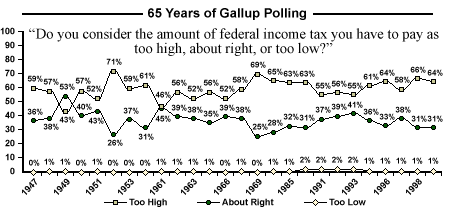 |
9. Legality of Abortion
Gallup has polled extensively about the issue of abortion since it emerged as a national public opinion issue with the landmark, but controversial, 1973 Supreme CourtRoe vs. Wadedecision. The past quarter century of polling has consistently shown that the public holds a complex set of opinions about the issue: on the one hand, viewing abortion as immoral and favoring protection of the unborn in most specific circumstances; on the other hand, favoring theRoe v. Waderuling and respecting the privacy arguments made by those seeking to preserve a woman's right to choose abortion.
Gallup's standard measure of public opinion about abortion -- the question asked most frequently and with consistent wording -- is summarized in the chart below. The question asks whether abortion should be "legal under any circumstances," "legal only under certain circumstances," or "illegal in all circumstances." More recently Gallup has asked a follow-up of people in the middle group to clarify their position, and has asked Americans to classify themselves as either "pro-life" or "pro-choice." On the basis of these questions, Americans look to be nearly evenly divided between those generally in favor of broad abortion rights, and those who are generally opposed to them.
In terms of the basic trend measure, some movement can be seen over time, particularly in the percentage favoring broad abortion rights. The most significant change in public attitudes occurred from the mid-1980s to mid-'90s, when public support for the strong pro-choice position (abortion legal under any circumstances) increased from 21% to 33%. However, support for that position has subsequently declined (coincident with a new public debate over "partial-birth abortions"). The result is that public opinion on this measure of abortion attitudes looks remarkably similar today to when it was first recorded in 1975.
The even more remarkable thing to notice about the graph is the basic continuity in the majority position. Since the question was first asked in 1975, half or more of Americans have staked out the middle ground -- favoring abortion under only certain circumstances. Similarly, ardent anti-abortion Americans have consistently represented the minority viewpoint throughout this period, while ardent pro-choicers have been somewhere in the middle.
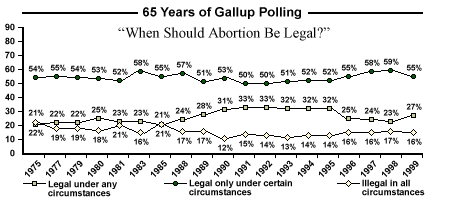 |
10. Approval of Labor Unions
The labor union movement began during the industrial revolution as a struggle against employers who exploited workers (including children) with long hours, low pay, and often-dangerous working conditions. Initially, efforts by labor unions to seek better working conditions were treated by the courts as acts of conspiracy punishable by law, and later as violations of antitrust laws. In 1916, Congress officially exempted labor unions from antitrust laws, and in 1935, Congress passed the National Labor Relations Act, which established the right of workers to organize and required employers to accept collective bargaining.
A year later, Gallup first asked Americans whether they approved or disapproved of labor unions. As the graph below shows, approval has always exceeded disapproval by substantial margins, although there has been some variation -- from a high of about 75% approval in the mid-1950s to a low of 55% in the late 1970s and early 1980s. Today, despite the relatively low number of households in which someone belongs to a union -- 18% -- Americans continue to approve of labor unions by a substantial margin, 66% to 29%.
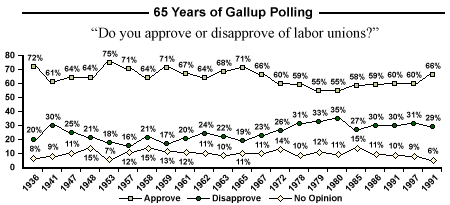 |
11. Use of Alcohol
In 1919, the 18th Amendment to the U.S. Constitution went into effect, prohibiting the sale and consumption of alcoholic beverages. Complete enforcement proved to be impossible, and 14 years later, adoption of the 21st Amendment repealed the failed experiment of prohibition.
Some idea of how difficult it was to enforce prohibition can be found in the accompanying graph, showing how many Americans "have occasion to use alcoholic beverages, such as liquor, wine or beer." When Americans were first asked that question in 1939, six years after the repeal of prohibition, almost six in ten (58%) said that they would occasionally imbibe, while 42% said they were "total abstainers."
Over the next six decades, the number of admitted drinkers has gone as low as 55%, but for the most part has remained at about 60% or higher, with peak numbers found in the 1970s -- from 68% to 71%. In the most recent Gallup poll, 64% of Americans indicate they occasionally drink, while 36% say they never drink.
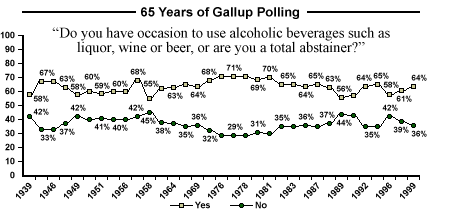 |
12. Death Penalty
Americans' support for the death penalty has undergone significant change over the years, to some degree coincident with the death penalty's actual use across the country. In the early 1950s, support for the death penalty was quite high -- at 68% -- but it fell to its low point of 42% in 1966, which also marked the only point in Gallup's history of asking the question that opposition outweighed support. During this time, the number of executions in the country dropped to very low numbers compared to much higher numbers in the 1940s and 1950s, and serious legal challenges to the constitutionality of the death penalty were raised. Support for the death penalty, nevertheless, soon began to rise, and even in 1972, when the Supreme Court essentially suspended the use of the death penalty, a majority -- 54% -- of Americans approved of its use. By 1976, other Supreme Court decisions reinstated the use of the death penalty by approving revised death penalty statutes in various states, and in 1977 the first execution in 10 years took place in Utah. By this point, in the late 1970s and early 1980s, well over 60% of Americans supported its use.
The high point in American support for the death penalty came in 1994, at 80%. Although support remains high, it may be waning slightly; Gallup's most recent survey in 1999 showed that 71% supported its use in cases of murder. Critics through the years have argued that equal attention should be paid to questions that show that when specific alternatives to the death penalty -- such as guaranteed life in prison with no possibility of parole -- are stressed to respondents, support is lower. This is true, but Gallup polling indicates that even when these scenarios are laid out to respondents, a majority continues to say that it supports the death penalty's use.
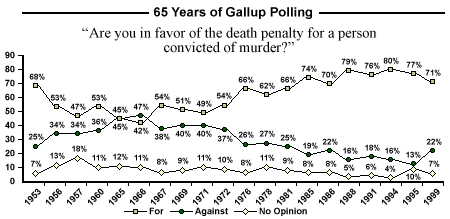 |
